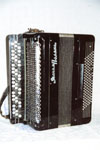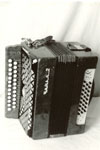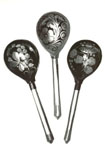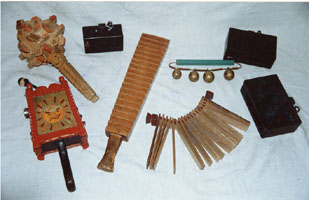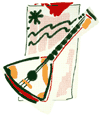
Musical instruments of "Skomorokhi" company
The
musical instruments, using by "Skomorokhi" company, represent all basic groups of Russian folk orchestra instruments:
the main string group, including "domra", "balalaika", and their orchestra varieties. Another group consists of
harmonicas and "bayan" (a sort of harmonica) and also some folk wood-wind instruments, for example, reeds and "jaleika"
(a sort of wooden pipe), providing more rich and expressive resonance. And the third group is percussion instruments -
rattles, wooden spoons, boxes, ect.
The name of the company - "Skomorokhi" - is an ancient Russian
word, which means pilgrim musicians, singers and clowns, and this connection with ancient times affects the instrumental
composition of the orchestra. The company members include in their programme household instruments, such as wooden
spoons, saw, scythe, launder board, beсides they use musical instruments, applied to different types of orchestra:
triangle, tambourine, drum, bell, ect,
BALALAIKA
- is an emblem of Russian instrumental folk music, although it is the most "young" Russian folk
instrument. The first documentary information about "balalaika" dates from the end of 17th century. The golden age of
"balalaika" is connected with the name of Vasily Andreev (1861-1918) - the founder of the fist Russian folk orchestra,
who created at the end of 19th century the orchestra varieties of "balalaika": prima, secunda, viola, bass, double-bass.
V. Andreev was the first Russian professional "balalaika"-player, who introduced Russian folk instruments to European
and American audience.
DOMRA
- is an
ancient Russian string instrument. The first information about "domra" dates from 16th century. At the end of 17th
century owing to Russian church perseculation of the pilgrim musicians ("skomorokhi") and "domra", as a "devil
instrument", it came out of use in musical practice and was reconstructed by Vasily Andreev only in 1896 according to
the ancient sample. Becides Vasily Andreev reconstructed the orchestra varieties of "domra" - small "domra", viola
"domra", bass "domra".
BAYAN
- is a Russian
type of harmonica. It is a keyboard instrument, more improved than harmonica. "Bayan" has a brilliant potential and it
can be used both as a solo and as an ensemble instrument. It was called "bayan" in honour of an ancient Russian epic
singer of 10th century - Boyan.
TULSKAYA HARMONICA
- is a type of Russian accordion. Accordion ("harmonica") came to Russia from Western Europe at the beginning of 19th
century and was improved by Russian music masters. As the result of this improvement several dozen of "harmonica"
varieties adapted for special features of Russian folk songs and dances appeared. The bigest centre of Russian harmonica
manufacture was in Tula city.
SARATOVSKAYA HARMONICA
- is a type
of Russian accordion.
GUSLY (psaltery)
-
is one of the most ancient string pluck instrument of Eastern slavs. The first information about it dates from 6th
century. One of the psaltery varieties is using at the folk orchestras as a solo instrument.
JALEIKA
- is an instrument of Russian shepherds, a folk pipe. It utters a very snuffling and harsh sound, but at
the same time the sound is very sad, pitiful (the name of this instrument -"jaleika" comes from Russian word, which
means - "pity", "compassion").
REED
- is a folk flute. It looks like a wooden pipe with
holes. The timbre of a reed reminds the sound of a flute, but it is more warm and soft.
KUVICKLY
- is a set of wooden pipes. Each pipe utters just one high whistling sound. "Kuvickly" has no definite
sound range and the pipes (each performer has 5 or 6 pipes) are chosen separately each time.
VARGAN
- is an ancient Russian instrument. It looks like a small metal horseshoe with a steel tongue and a hook
on it in the centre of the horseshoe. This instrument was widespread in many countries and in 19th century in Germany a
special composition for "vargan" and symphonic orchestra was written.
WOODEN SPOONS
- are ordinary painted spoons of Russian peasants. The sound comes out by knocking
one spoon over another and it looks like the sound of castanetas, but the timbre of the spoons is more open.
TRESCHOTKA (rattle)
- is a percussion instrument, a set of wooden boards, threaded on a
string when shaking the instrument utters a sharp clicking sound it is using for rhythmical accompaniment of different
songs and dances.
KOKOSHNICK
- is a
percussion instrument made as wooden frame, covered with any material and a wooden ball, fastened to the upper part of a
frame by a strap.
BUBEN (tambourine)
- is a percussion instrument. It is a wooden circle with
a leather diaphragm stretched on it with different peels and metal plates inside the circle. "Buben" is known as the
instrument of Russia pilgrim musicians ("skomorokhi").
RUBEL
- is an ancient Russian
household article. It was used for linen ironing. It looks like a hollow cog-bar. A sharp, clicking sound is deriving by
drawing the wooden stick over the cogs.
SHARKUNOCK
- is a percussion instrument (a kind of maracas), made of birch bark comes from the verb, which means
"to shuffle".
BUBENTSY (bells)
- are hollow metal balls with metal pieces inside. When
shaking, these bells are ringing with a soft melodious sound. They were used for carriages ("troika's").
BICH (lash)
- is an instrument, which consists of two boards, connected with each other. A
sharp sound comes out when one board knocks over another.
BOXES
- are wooden instruments, hollow inside, which utter different pitch.
|











